Root pruning is a method for preventing plants from becoming root bound while still keeping them in the same pot. As the term indicates, it means to prune away parts of the root system and that way allow the plant to keep growing in the same pot without running out of space.
I learned about root pruning rosemary from an incredibly knowledgeable employee at a large local garden center. He has more than 50 years of experience in gardening and was thrilled to share some tips and tricks. I have been testing what he taught me for some time now and it seems to work extremely well.
In this article, I teach you absolutely everything you should know about root pruning your rosemary. Here is what I get into:
- The best and easiest way to root prune rosemary
- Why it can be important to root prune rosemary
- How to tell if you need to prune your rosemary’s roots
- How often rosemary should be root pruned
- The best time of the year and day to root prune rosemary
- Common mistakes people make when root pruning rosemary
- The tools needed for root pruning rosemary
- Risks and disadvantages of pruning rosemary’s roots
With that said, let’s get into it.
How to Root Prune Rosemary to Keep It Healthy (Easiest Way)
Pruning your rosemary’s roots is easy and is a way to keep it healthy and happy without having to move it to a larger pot because it runs out of space.
The easiest way to root prune rosemary is to cut away the bottom third of its root system with a saw or a serrated knife and pruning shears for tougher roots. Put new soil at the bottom of the pot, water it lightly, and place the plant back in the pot.
Here is what I mean:
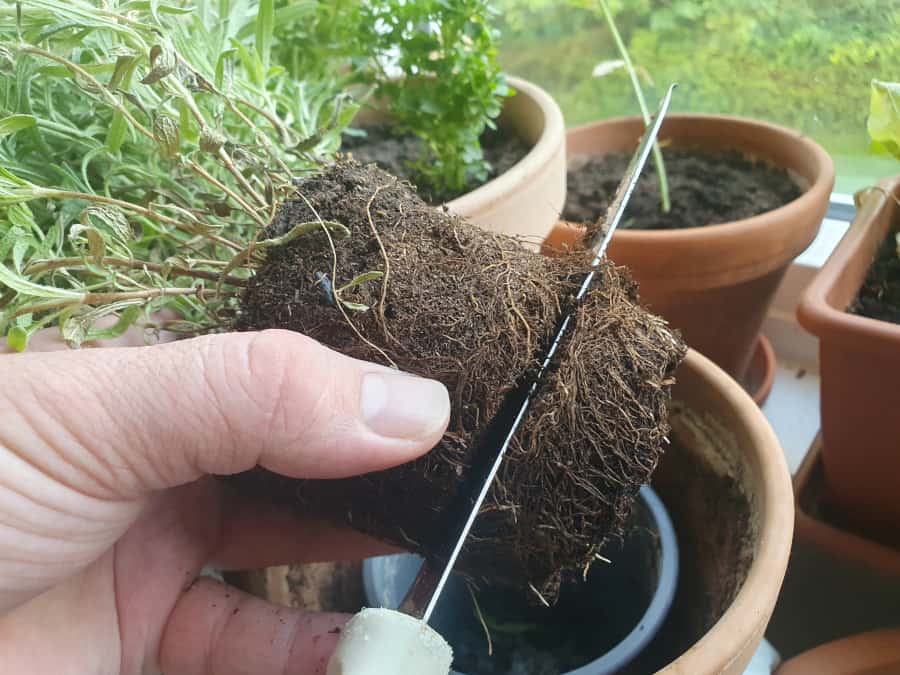
Here is a step-by-step guide:
- Grab your rosemary at the base and carefully lift it out of its pot
- Remove the bottom third of the root system with a saw, serrated blade, or pruning shears
- Fill the bottom third of the pot with sandy soil
- Water the soil in the pot lightly
- Put the plant back into the pot
You should never cut away more than about a third of the roots at the same time as that can make it difficult for the plant to adapt which can lead to problems. That’s more or less what I do in the photo above.
It is also important that you put the right amount of soil in the pot before putting the plant back in it. The key is that the base of the plant should be at the same level in the pot as before you pruned its roots. So if you removed the bottom third of the roots, fill the bottom third of the pot with new soil.
Use sandy soil that drains well and is low in organic matter.
Why Root Pruning Rosemary Can Be Important
Potted rosemary will eventually run out of room for its roots and become root bound which, as the term indicates, means that the roots become bound by some barrier, typically the walls of a pot. When that happens, the plant can’t obtain the water and nutrients it needs, which leads to stunted growth and eventually the death of the plant if the problem isn’t solved.
You can transplant the plant to a larger pot or into the ground so solve that, but if you want to keep it in the same pot, root pruning is the best solution.
Once you prune the roots on your potted rosemary, it frees up room for them to continue to grow without requiring more space. That way, you can keep your plant in the same pot for much longer.
How to Tell if Your Rosemary’s Roots Need to Be Pruned
It can be difficult to know if you need to prune your rosemary’s roots since you can’t see them without removing your plant from its pot.
There are a few signs that indicate you might have to do it, though.
- Your plant grows slower or stops entirely
- The foliage is drying out
- The leaves turn yellow or brown
- Roots are coming out of the pot’s drainage hole
These symptoms can all occur if the roots run out of room since it prevents the plant from obtaining the water and nutrients it needs. That said, the first three signs I listed can also be symptoms of other issues.
The only certain way to tell if your rosemary needs to be root pruned is to lift it out of its pot and look at the roots. If it looks like mine in this photo, you need to either prune its roots or transplant it somewhere with more space.
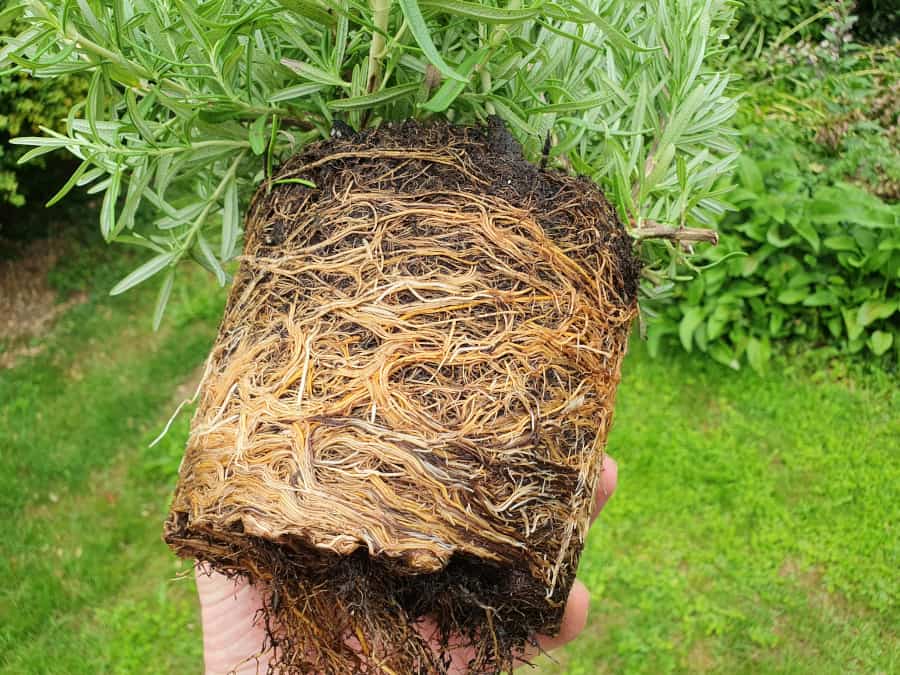
As you can see in this photo, the roots all look very fresh and healthy. That’s a great sign. It means that the plant is in good shape despite running out of room. That said, you need to either transplant it or prune its roots as soon as possible to avoid issues because, as you can see, there is not much room left.
How Often Rosemary Should Be Root Pruned (How to Know)
Rosemary can grow a quite comprehensive root system so unless you want to repot it into larger pots once in a while or put it in the ground, you need to prune its roots occasionally.
Generally speaking, rosemary should have its roots pruned one time per year to prevent it from outgrowing its pot. That said, if the plant becomes root bound faster than that, its roots should be pruned again even if it hasn’t been a year since the last time.
It is important that you don’t do it too often as that can stress the plant and cause problems such as preventing it from obtaining nutrients and water properly, which can kill the plant. That’s why once per year is my general recommendation.
One crucial thing to keep in mind is that you most likely shouldn’t root prune your rosemary at any time of the year. I explain why below.
When to Root Prune Rosemary (Best Time of the Year and Day)
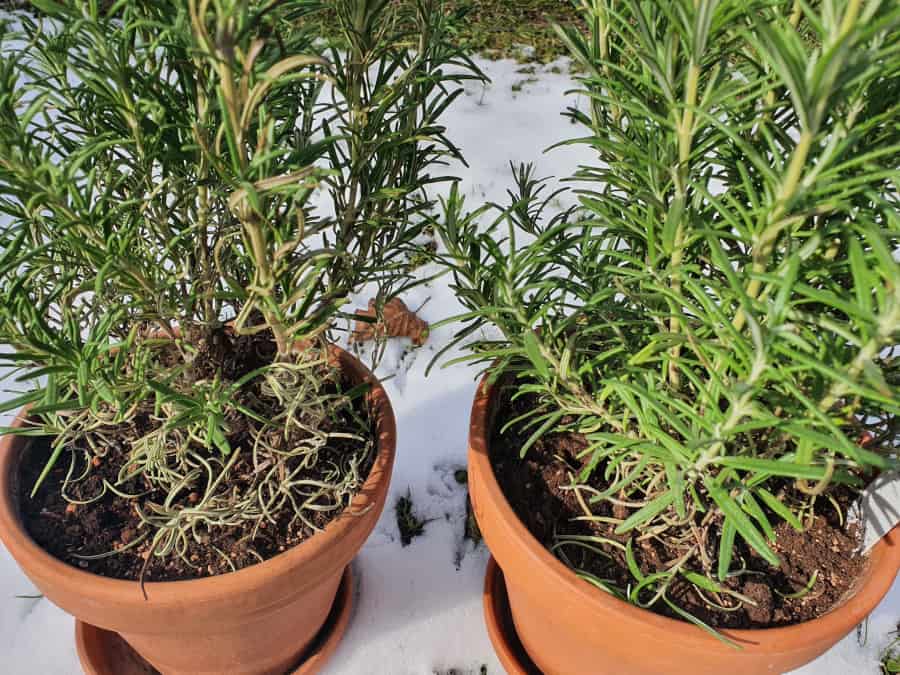
The best time to prune the roots of a rosemary plant is in the spring. That way, it has a full season to regrow its roots and become strong before a potentially cold winter. This gives it the highest chance to survive.
The best time of the day to do it is in the morning since it will have a full day of sunlight right away. This gives it a slightly higher chance to adapt to the new situation than if you did it in the evening.
The time of the year is more important than the time of the day. Your plant will most likely be fine if you prune its roots in the evening but I recommend doing it in the morning if you can.
The most important thing to keep in mind is that you shouldn’t root prune your rosemary when it is too cold. The roots will die if they are exposed to frost.
Even if it is cold but there isn’t frost, I still recommend waiting until spring if you can as low temperatures can still cause unnecessary and unwanted stress to the plant.
4 Mistakes You MUST Avoid When Root Pruning Rosemary
Root pruning is not a very complicated task but there is still a handful of mistakes that are easy to make and that can damage or even kill your plant.
Here is what you need to avoid:
- Removing too much of the root system
- Damaging the roots when pruning them
- Root pruning at the wrong time of the year
- Forgetting to water after root pruning
You should never remove more than a third of the root system at the same time as that can cause unwanted stress for the plant and make it difficult for it to adapt. The easiest way to do it right is to simply measure the height of the root system and cut it a third of the way from the bottom.
I have tried to illustrate what I mean here. The (almost) horizontal line indicates the height of the root system and the dotted vertical line indicates where you should cut. One third from the bottom.
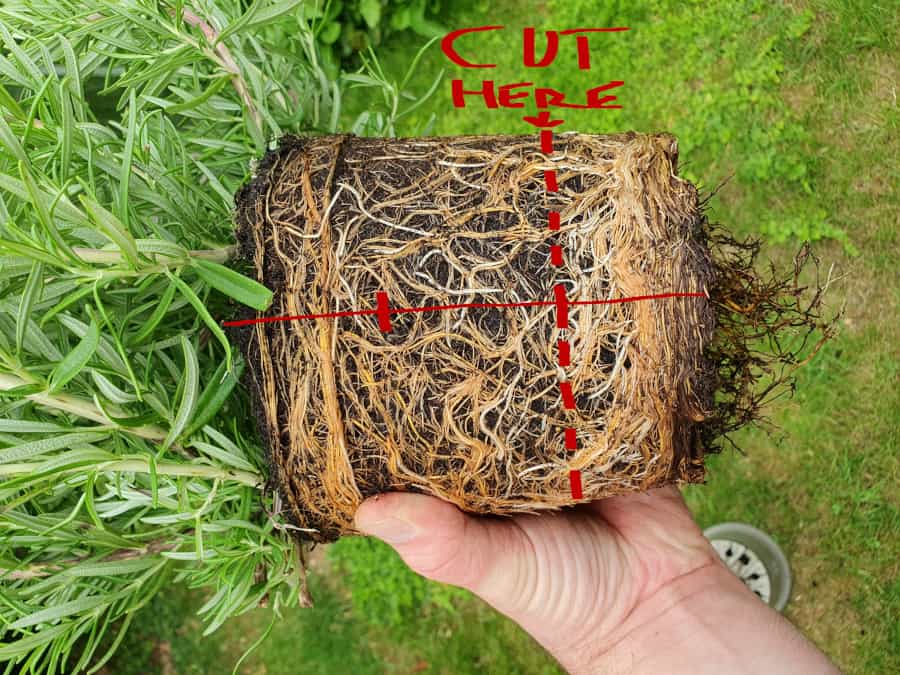
In my experience, the easiest way to cut the roots in a way that doesn’t damage them more than necessary is to use a saw or a serrated knife. It can also be useful to have pruning shears for some of the thicker roots.
Another easy mistake to make is to root prune your rosemary in the winter or when it is too cold. The roots will become damaged or even die if they are exposed to frost. As I covered earlier in this article, spring is the best time to prune rosemary roots.
Lastly, I have learned that plants adapt to situations like this much more easily if you give the roots a bit of water to work with. Simply spray or pour a bit of water on top of the new soil in the pot before you put the plant back in.
Tools Needed for Root Pruning Rosemary (Keep It Simple)
I’m sure you can use any number of different sharp tools for pruning roots but I like to keep it simple.
I have used:
- A saw
- A serrated knife
- Pruning shears
In my experience, the best tool for pruning rosemary roots is simply either a saw or a serrated knife.
If you have a saw, that’s probably the best option but I have also used a cheap bread knife for the task before and it worked just fine.
For small to medium-sized plants, this is usually sufficient but for larger plants with thicker roots, I have found that it can be easier to get through some of the thick roots if with pruning shears.
Disadvantages and Risks of Root Pruning Rosemary
While root pruning can be an excellent and easy way to prevent your rosemary from outgrowing its pot, it is not completely risk-free and it also has some disadvantages.
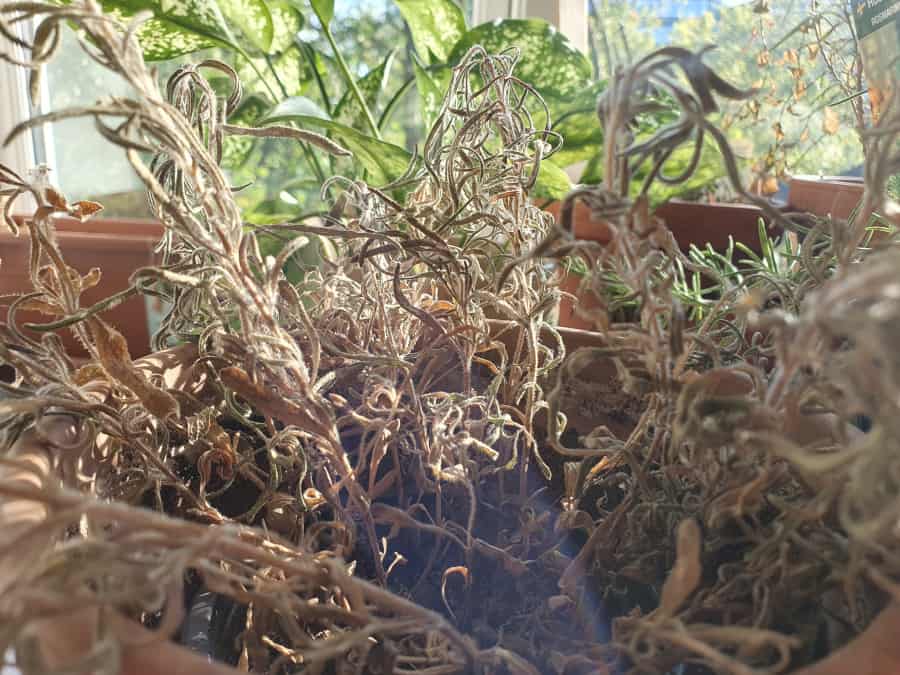
The biggest risk of root pruning is that the plant won’t establish itself and die after going through the process.
This usually happens if too much of the root system is removed at the same time. As I covered in this article, you should never remove more than a third of the root system at the same time.
This problem is easy to avoid if you just follow the tips I have shared in this article. That’s the way to reduce the risk as much as possible.
A disadvantage of root pruning is that it will cause the plant to grow much less than otherwise. The key to large rosemary bushes is a large and healthy root system, so if you prune the roots, it won’t be able to obtain as much water and nutrients as it requires to grow large.
Pruning the roots will also cause the plant to funnel energy into the roots to cause them to grow, meaning that less energy will be spent on producing new foliage.
Of course, this is only a disadvantage if you actually want your plant to get much larger. If you want to keep it contained and not get too big, root pruning is great.
If you don’t want to take the chance or you prefer that your rosemary gets as large as possible, repotting or putting it in the ground might be better options for you than root pruning. I have written guides for both. You can learn how to repot rosemary here and how to put rosemary in the ground here.
